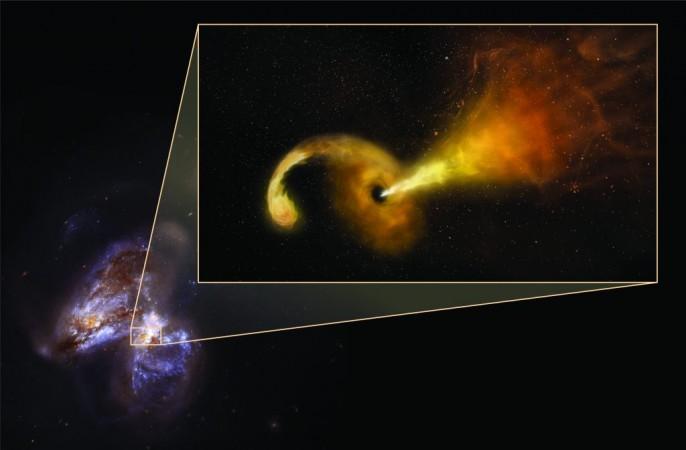
Astronomers have managed to directly image, for the first time ever, a star being chomped down by a supermassive black hole. The dramatic image shows the star getting shredded while a huge explosion sends jets of particles outward, as it dies a horrible death.
Scientists from the National Science Foundation's Very Long Baseline Array (VLBA) tracked the entire event using radio and infrared telescopes, says a release by the National Radio Astronomy Observatory (NRAO). The event took place in a pair of colliding galaxies named Arp 299 and it is about 150 million light years away from Earth.
At the very centre of this colliding galaxy, there is a supermassive black hole, notes the release. It is about 20 million times larger than our Sun. The star that became prey to the black hole had a mass that was more than twice the Sun's.
"Never before have we been able to directly observe the formation and evolution of a jet from one of these events," said Miguel Perez-Torres, of the Astrophysical Institute of Andalusia in Granada, Spain. Called Tidal Disruption Events (TDE), they are rarely detected, but scientists hypothesise that they happen quite frequently.
Only a few weeks back, reports emerged of the fastest expanding black hole ever seen, eating several stars every week, but even then, the actual event of star eating was not directly captured through telescopes.

Researchers suggest that the mass sucked out from the doomed stars settle into a disk, rotating around the black hole. This also led to it emitting intense radiation- including X-rays and visible light, while at the same time ejecting massive jets of material outward at nearly the speed of light from the poles of the newly formed disk, explains the release.
Astronomers have been tracking this event since January 2005 using the William Herschel Telescope in the Canary Islands where they first noticed a bright burst of infrared (IR) emissions coming from within the Arp 299. By July that same year, the VLBA team recorded a new and distinct stream of radio emissions coming from the same region.
Most galaxies have supermassive black holes, notes the report. Even the Milky Way has one in the centre. These black holes are spots in the universe where mass is concentrated so much so that its gravitational pull is too strong for anything to escape it, including light. Black holes that are deemed supermassive has a tendency to continuously draw matter toward itself and material that gets pulled toward it ends up forming a disc around the black hole itself. At the same time, superfast jets of particles are also launched outward, explains the report.
"Much of the time, however, supermassive black holes are not actively devouring anything, so they are in a quiet state," Perez-Torres explained. "Tidal disruption events can provide us with a unique opportunity to advance our understanding of the formation and evolution of jets in the vicinities of these powerful objects," he added.
Mattila and Perez-Torres led a team of 36 scientists from 26 institutions around the world in the observations of Arp 299. Their findings will be posted in journal Science.








